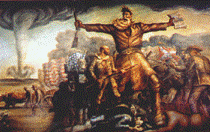History, Department of
Date of this Version
April 2006
Abstract
An analysis of Marxist conceptions of the good and the beautiful and their relationship to alienation, “Ugly and Monstrous” argues that Marxism was ultimately a set of aesthetic beliefs, one that paradoxically called for the temporary cessation of all attempts to create beautiful artwork. Marx understood beauty as Kant had – that it is the result of the harmonization of the faculties that occurs when a disinterested observer encounters a work of art. Capitalism gives to all works (art included) monetary value, and all observers become interested consumers, debasing art appreciation and killing the human desire (and need) to experience the beautiful.
The work of later Marxists, particularly Walter Benjamin and Herbert Marcuse, take the Marxist position to its logical conclusion, that any art in the age of capitalist exploitation and worker alienation must, by its nature, be political. The best way to judge art, according to these twentieth century Marxist aestheticians, is to measure the level of alienation the work contains. The more alienated the artist and the work are, the more correct the political statement is. The work, which can never be pleasant and must always and ever agitate, is thus judged good. It cannot, however, be beautiful because the work retains utility – it encourages political action on the behalf of the community and the individual and is not a whole in and of itself. Beautiful art, cannot exist until a communism has been established. Thus Marxist (and neoMarxist) aesthetics mandate the impoverishment of the senses and the death of beauty.


Comments
Paper delivered at the 1st Annual James A. Rawley Graduate Conference in the Humanities, Lincoln, NE. April 8, 2006. Copyright © 2006 Chris Rasmussen.